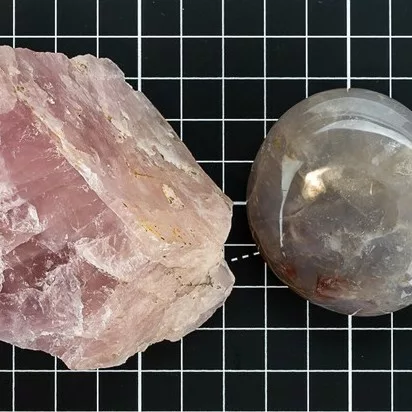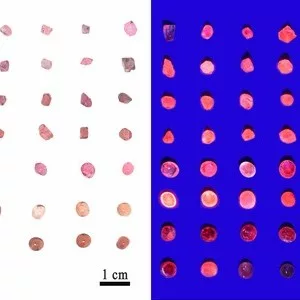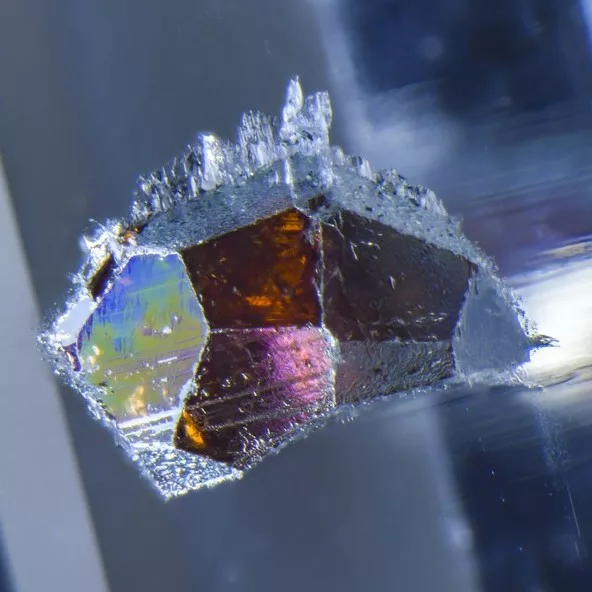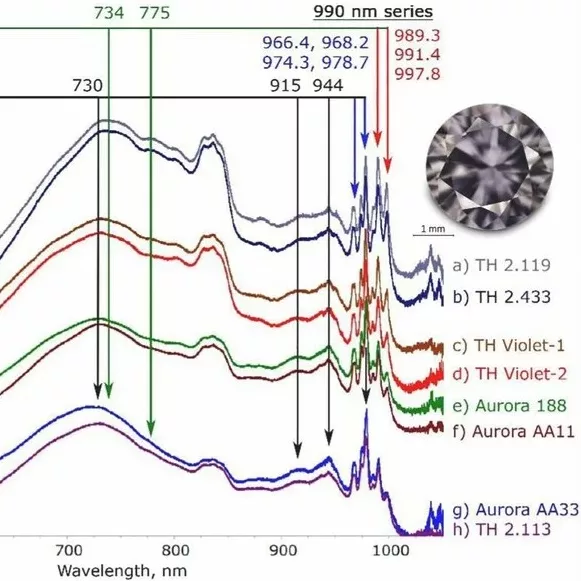Rose Quartz: Journey Into the Nano-Jungle
Keywords: rose quartz, dumortierite, fibre, fiber, boron, colour, color, stability, fading, nano, asterism
Introduction
Massive rose quartz is a readily available mineral ranging in colour from pink to salmon- or lavender-pink (Figure 1). Given its popularity in the market, it might be assumed that most aspects of its formation and the mechanism producing its colour would be well understood. Nevertheless, as is shown in the following review of prior work by other investigators, outstanding questions remain. These serve to guide our planned further studies into the nature, cause, long-term permanence and geological implications of the rose colour in quartz.
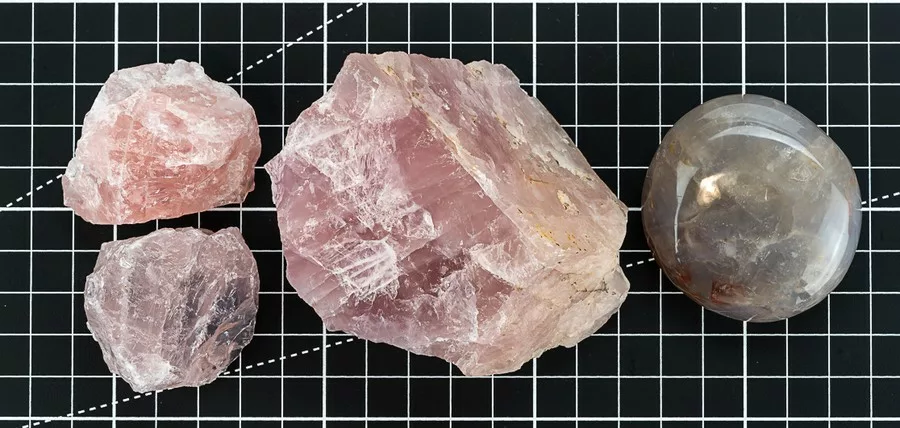
Definition of pink-coloured quartz types
Part of the confusion with rose quartz lies in the tendancy to apply this name to any pink-coloured quartz, regardless of the cause of colour, crystal habit, or other differences. The most common type is massive rose quartz that displays no external crystal morphology and always shows a turbid translucent to milky transparency. Several investigators found that dissolution of this material in hydrofluoric acid left a fibrous residue that matched the original colour of the samples. Analysis of the fibres using high-resolution transmission electron microscopy and spectroscopic and diffraction techniques subsequently identified the cause of colour in massive rose quartz to be a nano-scale fibrous dumortierite-like material (DLM) (Applin & Hicks, 1987; Goreva et al., 2001; Ma et al., 2002). This rose quartz is the focus of the current discussion. It is distinct from similarly coloured small turbidity-free euhedral crystals that form in more evolved pegmatites, and owes its (unstable) colour to irradiation-induced colour centres associated with phosphorus and Al replacing silicon in the quartz lattice (Maschmeyer & Lehmann, 1983). Hori (2001) has suggested that this latter material should be known simply as “pink quartz”. Additional occurrences of pink-hued quartz owe their colour to inclusions, coatings or other mechanisms.
Colour and the role of fibres of a dumortierite-like material Rose quartz is expected to be pink, but quite pale material still displays a translucency that suggests the presence of inclusions that scatter light. Kunz (1968) recorded localities in Maine that graded in colour from an imperfection-free, opalescent, hyaline-like white to a rich rose colour. Similarly “white rose quartz” is currently offered on the market. Large regions of white quartz, potentially with a different crystallization history, are often intermixed with the rose in the core of a pegmatite, just as white quartz makes up part of the pieces shown in Figure 2. Reduced colour intensity could indicate any of the following conditions: (1) the quartz contains no, or a very low concentration, of DLM fibres; (2) the fibre size or orientation impacts colour; (3) dense fracturing or a high concentration of microscopic fluid inclusions masks colour; (4) the DLM fibres might be present, but colourless themselves. Dumortierite is commonly blue, but pink, violet and even colourless forms also occur. The colour of dumortierite has been attributed to heteronuclear intervalence charge transfer (IVCT) between Fe2+ and Ti4+ that substitute for Al in face-sharing octahedral sites in the straight chains of the structure (Platonov, 2000). The possible contribution of an Fe2+ to Fe3+ IVCT has also been discussed by Alexander et al. (1986). Assuming similarity between the DLM and its namesake, the quartz colour may be dictated by the concentration of Fe and Ti in the DLM fibres.
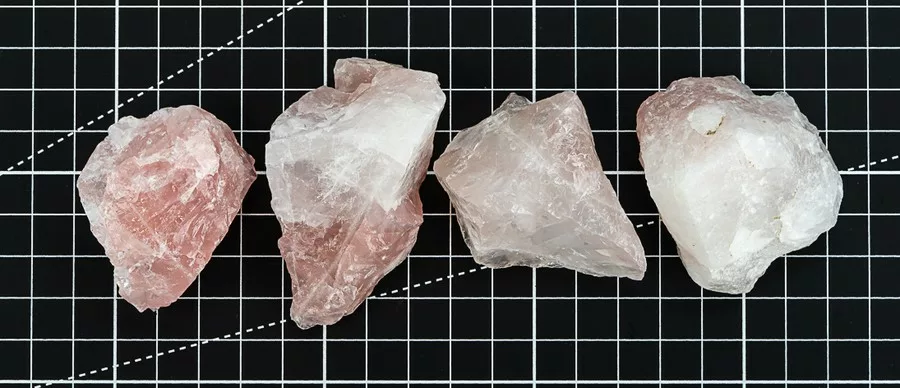
Asterism in rose quartz
The reported presence of oriented rutile needles in rose and blue quartz (von Vultée, 1956) has contributed to their acceptance as a cause of colour and asterism. The presence, however, of oriented DLM nano-fibres seems a more probable explanation of the majority of cases, considering that Ma et al. (2002) found no evidence of rutile in any of the 29 samples examined. Asterism is not uncommon in rose quartz, but also not ubiquitous. Diasterism (with illumination from behind) with six-rayed stars or more is most prevalent (Figure 3) while epiasterism is often visible in more opaque spheres. It is interesting to ask why all rose quartz is not asteriated if the DLM fibres are always present. This could simply be the result of inclusions masking the effect, or it could be related to a crystallographically controlled versus random orientation of the DLM fibres, which in turn could be related to the cooling history experienced by a given sample of rose quartz.
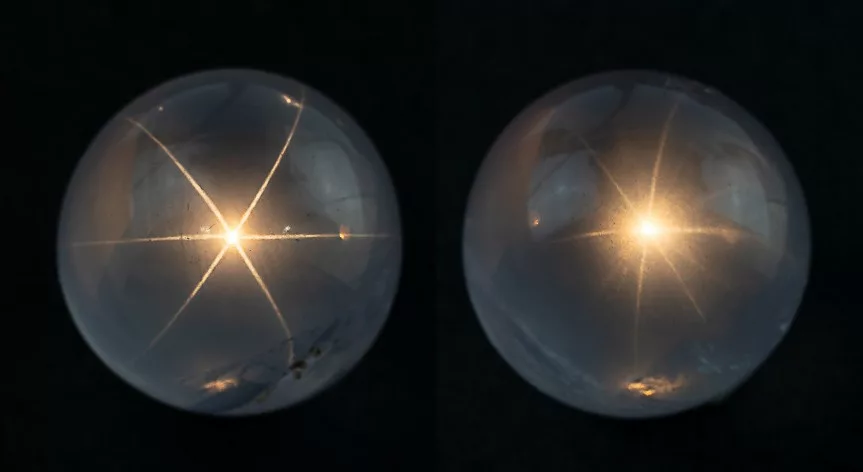
Stability of the pink colour in rose quartz
There are conflicting reports as to whether the colour in rose quartz is permanent or prone to fading upon exposure to sunlight or normal ambient heating. Although it is unlikely that an intervalence charge transfer such as that exhibited by dumortierite or blue sapphire will fade, the lore of fading is so oft-repeated that claims should be tracked down where possible, and scientifically evaluated to identify possible alternative mechanisms behind the colour.
Boron and the nature of the dumortierite-like material
Boron is an incompatible element that, along with Li, Be, P, F, water and other species, becomes progressively enriched by fractionation in the melt. Importantly, B can behave as a fluxing agent that modifies the melt structure and depresses the temperature of crystallization. Given the seemingly ubiquitous presence of a B-containing dumortierite-like mineral, it might be expected that crystallization of rose quartz would take place at lower temperatures than for other types of quartz (e.g. milky quartz), implying that its presence could significantly impact the crystallization history of the rocks in which it is found. Furthermore, the fibres themselves bear further inspection to understand why they have developed a superstructure of regular dumortierite where the a and b parameters are twice the norm. Applin and Hicks (1987) were among the first to isolate these fibres from rose quartz and identify them. They reported similar fibres in a couple of examples of pegmatitic non-rose quartz and suggested that DLM fibres in quartz may be more prevalent than previously thought.
Further investigation
Research is being undertaken that will seek to address: (1) the likelihood that a DLM is present in most, if not all, rose quartz; (2) the mineralogical nature of the specific DLM present (chemistry, crystal structure); (3) whether certain varieties of rose quartz demonstrably fade upon exposure to sunlight; (4) the nature of the exsolution of a DLM as the cause of asterism in rose quartz and (5) the geological impact and significance of rose quartz in select pegmatite systems. It will employ samples obtained from several Canadian and international localities that are well-known for their occurrences of rose quartz.
References:
- Alexander, V.D., Griffen, D.T., Martin, T.J., 1986. Crystal chemistry of some Fe- and Ti-poor dumortierites. American Mineralogist, 71, 786 – 794.
- Applin, K.R. and Hicks, B.D., 1987. Fibers of dumortierite in quartz. American Mineralogist, 72, 170 – 172.
- Goreva, J.S., Ma, C., Rossman, G.R., 2001. Fibrous nanoinclusions in massive rose quartz: The origin of rose coloration. American Mineralogist, 86, 466 – 472.
- Hori, H., 2001. Nomenclature of quartz color variations – pink and rose. The Mineralogical Record, 32, 42. • Kunz, G.F., 1968. Gems & Precious Stones of NorthAmerica. Dover Publications, Inc., New York, 367 pp.
- Ma, C., Goreva, J.S., Rossman, G.R., 2002. Fibrous nanoinclusions in massive rose quartz: HRTEM and AEM investigations. American Mineralogist, 87, 269 – 276.
- Maschmeyer, D. and Lehman, G., 1983. A trapped-hole center causing rose coloration of natural quartz. Zeitschrift für Kistallographie – Crystalline Materials, 163(3), 181 – 196.
- Platonov, A.N., Langer, K., Chopin, C., Andrut, M., Taran, M., 2000. Fe2+ – Ti4+ charge-transfer in dumortierite. European Journal of Mineralogy, 12, 521 – 528.
- Von Vultée, J., 1956. Die Verwachsungsgesetze der orientierten Einlagerungen von Rutil in Quarz. Zeitschrift für Kristallographie, 107(1 – 2), 1 – 17.

